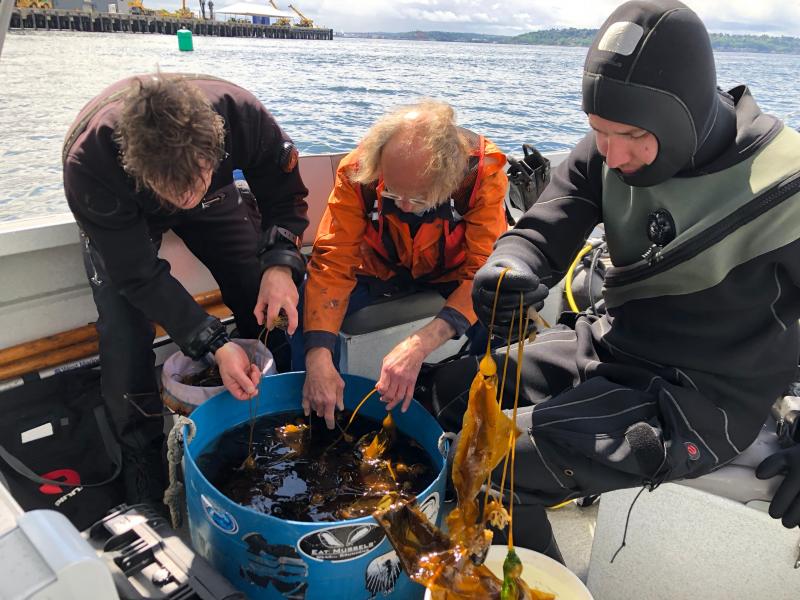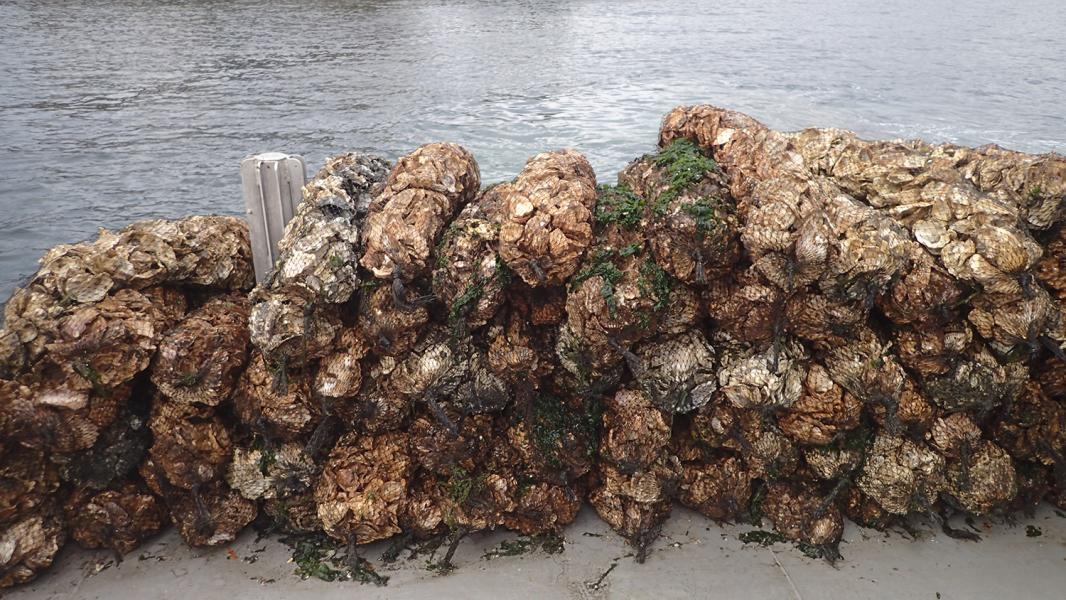Smith Cove is a busy place. Located in north Elliott Bay, between Terminal 91 and Elliott Bay Marina, it’s home to fishing and commercial vessels, a park, a marina, two cruise ship berths that hosted 155 cruise ship calls in 2018, and provides access to two busy railway networks. Terminal 91 bustles with passenger and cargo transfer, warehousing, large vessel fishing gear fabrication, food processing, and other maritime operations year-round, no matter the season.
What is perhaps Smith Cove’s most surprising industry, however, is largely hidden from view. Smith Cove is home to a pilot project where marine scientists and Port officials are testing techniques to restore and improve critical aquatic habitat in urban bays. Just below the water’s surface, strategically placed native oysters and aquatic plants are maturing and multiplying, combining to produce about 23 acres of “blue carbon” infrastructure. The project is important to the health of Puget Sound and could yield practical and cost-effective actions to counteract the impacts of climate change to the marine environment.
Keeping the sound healthy
“Blue carbon” refers to carbon captured in ocean and nearshore environments, assimilated as biomass and stored (or sequestered) in marine sediments. Blue carbon processes are critical to concerns for acidification of marine areas due to increases in atmospheric carbon dioxide. In Puget Sound, kelp, eelgrass, and shellfish are important elements in blue carbon processes, ensuring productive, resilient and carbon-rich marine conditions.
The Port’s Blue Carbon Pilot Project was envisioned by a former Port graduate student intern and is receiving technical and marine science support from the Puget Sound Restoration Fund and the Washington State Department of Natural Resources (DNR). The project kicked off with important baseline surveys in the spring of 2018.
In October 2018, three tons of oyster shells were placed in the lower intertidal zone. Before placement, Puget Sound Restoration Fund experts seeded the shells with native Olympia oyster larvae at the Kenneth K. Chew Center for Shellfish Research and Restoration. Earlier this year, tiny bull kelp spores were planted in subtidal areas on Port property between Terminal 91, Elliott Bay Marina, and Smith Cove Park. Then, eight test eelgrass transplant plots were established in June 2019.
The project is a good example of restoration aquaculture and its goal is to trap carbon in the environment, reduce ocean acidification and improve water quality all by enhancing natural processes. The eelgrass and kelp create habitat and resting places for sea life like chinook salmon. Oysters also act as filter feeders, removing pollution from the water.
The Blue Carbon Project also meets a number of objectives in the Port’s Century Agenda which, among other goals, seeks to restore, create, and enhance 40 acres of marine habitat in the Duwamish watershed and Elliott Bay.

Building a plan for long-term sustainability
In January, Smith Cove became the newest addition to the Acidification Nearshore Monitoring Network, a DNR program that tracks climate change and acidification at 10 sites across the state. Through this network, Smith Cove is part of an experiment to understand the conditions that lead to success for native oyster restoration.
According to Betsy Peabody, executive director of the Puget Sound Restoration Fund, “restoring a healthy, living ecosystem requires the right partners, the right science, and the right priorities. The Port’s Smith Cove pilot project hits all those notes and gives us a chance to re-create a diversity of habitats and species in an urban location and then watch to see if these habitats can improve conditions along the Seattle waterfront.”

“(Now), we go into a long-term monitoring period where we’ll study the site for three years and see how much carbon is being sequestered,” says Jon Sloan, Senior Environmental Program Manager at the Port of Seattle. “How much are the chinook salmon using this new habitat? And is it improving shoreline resiliency from sea level rise?”
Learning lessons to guide future enhancements
Expectations are high for the Blue Carbon Pilot Project. Kelp and eelgrass trap dissolved carbon at a significant rate – as much as a ton of CO2 per acre annually. Even as a pilot project, the Smith Cove project is expected to sequester 10 tons of carbon every year, or the equivalent of more than 1,000 gallons of gasoline combustion. The oyster bed is poised to support more than one million oysters as the project matures. One million oysters flourishing at the project site would filter an estimated 50 million gallons of Elliott Bay water per day. That’s roughly equal to the volume of water at the Smith Cove project site.
The shoreline is also expected to benefit from the enhancements. As sea levels rise and storms intensify, shorelines are becoming increasingly prone to erosion. Kelp, eelgrass, and shellfish play an important role in protecting shorelines, dissipating energy, capturing sediments, and reducing erosion.
At the end of the pilot project, technical information and verified techniques will be available to guide similar self-sustaining, restorative actions in marine environments in other Puget Sound locations.
“(Hopefully) we can demonstrate recovery in an urban environment, show that our effort is productive and that it works, prove that our investments are sound, and deliver those values to the residents of King County, as well as Puget Sound-wide,” says Sloan.
“This project is an innovative example of the Port of Seattle’s commitment to restore the Salish Sea and all those dependent on it,” says Commissioner Fred Felleman. “It will only be through such collaboration that we can successfully tackle the challenges of climate change and recover our salmon and killer whale populations while enabling the ongoing commercial and recreational use of Elliott Bay.”
Originally published in Crosscut




